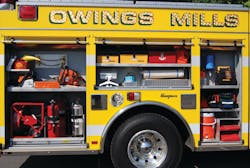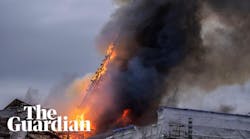In the last installment of The Apparatus Architect (November 2010), we reviewed some concepts for maneuvering through the bid-procurement process to ensure your department and community will receive competitive bids for your next piece of apparatus. Much of the groundwork that is established early with your committee will pay off dividends in the end with a smooth delivery and acceptance process for the vehicle.
As taxpayers are becoming more sensitive to large capital expenditures, we must do our homework to provide for a logical and accountable process from start to finish. While the financial picture may not look bright for the immediate future, this is no reason to sit back and forestall your vehicle-acquisition program. A detailed assessment of your fleet with a well-developed fleet-replacement plan will ensure the needed apparatus and equipment will be available to protect your community. An apparatus architect can provide you with a fleet evaluation and provide your fire department with a detailed fleet-replacement program. With this in mind, in this article we will focus on several departments that recently placed into service well-designed engine apparatus to meet their specific needs.
The La Plata Fire Department in Charles County, MD, operates from a single station staffing two engines, a rescue engine, a tractor-drawn aerial ladder, a tanker and a brush unit. Under the command of Chief Jason Moore, the volunteer department responds to more than 1,400 alarms each year in its first-due area as well as other areas of Charles County. The department had sought to replace its twin 1988 Pierce Lance pumpers with vehicles that had a short, maneuverable wheelbase with a low hosebed for advancing attack lines.
The department apparatus committee met with several prospective manufacturers and after the bids were evaluated, awarded a contract to Pierce Manufacturing for two Arrow XT pumpers. These units were constructed on a 169½-inch wheelbase with an overall length of just 30 feet. Each engine carries a 1,500-gpm pump and 500-gallon, FDNY-style water tank and is equipped with six pre-connected attack lines together with supply- line beds for three- and four-inch hose. The apparatus bodies are fabricated from stainless steel with extensive tool and equipment mounting. Each pumper is equipped with several safety components such as front down-view mirrors, backup cameras, reinforced front bumper and LED warning lights. These new pumpers prove that "bigger is not always better" and are a good example of well-designed engine apparatus. While some departments continue to "supersize" their apparatus, the officers and members of the La Plata Fire Department worked diligently to design a pair of practical, short-wheelbase units to meet the needs of the community.
In upstate New York, the Syracuse Fire Department operates with 10 engine companies, six truck companies, a rescue company and several aircraft rescue and firefighting (ARFF) apparatus from 12 strategically located fire stations. The department, under command of Chief Mark J. McLees, annually responds to more than 20,000 alarms, employing well-developed tactics for structural firefighting. The department uses two-piece engine companies to deliver both EMS and suppression services. This concept dates back to 1972, when the department embarked on a radical reorganization plan to modernize operations with the construction of seven new fire stations and a complete replacement of all front-line apparatus within five years. All truck companies are provided with Sutphen aerial towers with a four-piece rescue company that is staffed with seven personnel. Each engine and truck company is staffed with four personnel on each shift. Each engine company operates with a full-size pumper together with a mini pumper that is used as an EMS first-response vehicle. These smaller four-wheel-drive units are equipped with composite bodies and reduce wear and tear on the larger apparatus.
Today, the department continues to provide for new apparatus on a regular basis under the auspices of an Apparatus Advisory Committee headed by District Chief David Reeves. The committee is made up of members from the maintenance division and training bureau as well as officers and company members. This input is reflected in the department's apparatus specifications, which are performance related and provide for an open and competitive bid process. For a number of years, all of the department's engine company units were equipped with 50- to 55-foot telescopic water towers. Due to financial considerations, the most recent engine apparatus were designed without the water tower device while making changes and improvements to enhance safety for operating members.
In July 2010, the department took delivery of two new Sutphen pumpers that were assigned to Engine Companies 3 and 7. These engines featured exterior cab compartments for storage of the drivers' gear and EMS equipment as well as storage area for the drivers' self-contained breathing apparatus (SCBA) under the forward-facing seats. The pumpers were built on a 200-inch wheelbase with an overall length of 31 feet, seven inches. The engines are equipped with a 2,000-gpm single-stage pump and 500-gallon low-profile water tank with a 50-gallon Class A foam cell.
The Syracuse Fire Department relies heavily on multiple pre-connected attack lines, with each engine outfitted with two 200-foot and two 300-foot attack lines with automatic nozzles. In addition, the units are provided with a front trash line and a pre-connected 2,000-foot Blitzfire line together with two supply-line beds, each with 700 feet of four-inch hose. The department's engine company procedures have been refined over the years as a result of fireground experiences to provide safe and efficient operations. The low crosslay beds and well-designed pump-panel layout provide operational benefits and simplify training for new drivers.
Additional maintenance and safety features such as a steel-reinforced bumper, an onboard chassis-lubrication system, non-slip step surfaces and a remote-control deck gun were provided on each apparatus. Due to severe winter weather conditions, the department specified stainless-steel body construction together with roll-up shutter doors and heat tapes for pump-panel gauges. The Syracuse Fire Department can be justifiably proud of its newest engine apparatus, which together with other department programs should strengthen the department's ISO Class 1 rating.
In Maryland, the Owings Mills Volunteer Fire Company operates as Station 310 in Baltimore County. Under the command of Captain Kevin Wallett, the station responded to more than 4,400 fire and EMS incidents in 2009, operating with two engines, a tractor-drawn aerial ladder, a brush unit, a medic unit and several support vehicles.
Current Owings Mills apparatus include a 1994 Seagrave TB 2,000-gpm pumper as Engine 311 and a 2003 Seagrave TT 100-foot tractor-drawn aerial ladder as Truck 313. Engine 312, a 2009 Seagrave TB-80CM pumper, is the station's newest piece of apparatus and was carefully developed by fire company members with the assistance of Life Member Denny Warren.
Engine 312 is a Seagrave Marauder II pumper equipped with several safety and maintenance enhancements, including a full stainless-steel cab, steel-reinforced front bumper, front crossover mirror, vertical exhaust and electronic stability control. Engine 312 is built with a wheelbase of 190½ inches and an overall length of 31 feet, five inches. The fire pump is rated at 2,250 gpm with a low-profile water tank carrying 500 gallons. The engine apparatus was specifically designed to provide for a short-wheelbase engine that could operate within the Owings Mills response area while providing the maximum amount of enclosed compartment space. With this in mind, the unit is not equipped with crosslay hosebeds, but rather has the pre-connected attack lines carried in the rear hosebed.
The left- and right-side pump panels each have pre-connected trash lines carried in the recessed hose wells. The rear hosebed carries 1,400 feet of five-inch and 550 feet of three-inch hose for supply lines. In addition, the engine carries two 200-foot 1¾-inch attack lines together with a 150-foot pre-connected 2½-inch line. An additional 300 feet of three-inch hose is carried for use as a leader line.
The body is fabricated of stainless steel and provided with seven enclosed lower-body compartments and four upper-body locker compartments. The body compartment layouts were set up to provide ready access to all tools and equipment by using an assortment of modules, tool boards, slide trays and adjustable shelves. The Owings Mills Fire Company has a long history of designing and operating unique rigs over the years and Engine 312 is no exception.
Some of our earlier articles in The Apparatus Architect series emphasized the importance of defining the mission of the apparatus and developing a comprehensive listing of tools, equipment and hose that would be carried on the unit. The ability to properly lay out the needed pieces of equipment within the body while allowing space for future growth will lead to a properly proportioned apparatus and not one limited in size by the depth of the bay in your fire station.
TOM SHAND, a Firehouse® contributing editor, is a 36-year veteran of the fire service and works with Michael Wilbur at Emergency Vehicle Response, consulting on a variety of fire apparatus and fire department master-planning issues. MICHAEL WILBUR , a Firehouse® contributing editor, is a lieutenant in the New York City Fire Department, assigned to Ladder Company 27 in the Bronx, and has served on the FDNY Apparatus Purchasing Committee. He consults on a variety of apparatus-related issues around the country. For further information, access his website at www.emergencyvehicleresponse.com.






